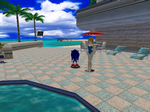The Dreamcast is a home video game console created and offered by Sega. The initial of the sixth generation of video game consoles, it was released in Japan on November 27, 1998, in The United States And Canada on September 9, 1999, and in Europe on October 14, 1999. The fifth and final home console created by Sega, the Dreamcast is the successor to the Sega Saturn, whose business failure triggered the firm to release it just 4 years after its precursor’s initial launch.
All qualified ready the Dreamcast were released on the GD-ROM style, an exclusive CD-based optical disc format jointly created by Sega and Yamaha Company that was capable of accumulating to 1 GB of data. The Dreamcast itself features local lockout. While the higher-capacity DVD-ROM layout was available throughout the console’s growth, its then-fledgling modern technology was deemed as well costly to execute at the time, which caused ramifications for Sega when competitors such as Sony’s PlayStation 2 came to market; the Dreamcast was unable to offer DVD movie playback when the general public began switching from VHS to DVD, and its games were incapable to make the most of the DVD’s greater storage space capability and lower expense. Furthermore, an exploit in the console’s duplicate security system by means of its support for the little-used MIL-CD layout effectively permitted customers to play several video games shed onto CD-Rs, with no hardware alterations.
The Dreamcast’s first release in Japan had 4 launch titles, which were Virtua Fighter 3tb, Pen TriIcelon, Godzilla Generations, and July.Read here redream games At our site The North American debut included 19 launch titles, which included highly expected ones such as Sonic Adventure, Soulcalibur, and NFL 2K. The European introduction was initially going to include 10 launch titles, however the listing boosted to 15 as its hold-up from the initial September 23 launch date allowed the inclusion of a handful of added titles. Due to the resemblance of the Dreamcast’s equipment with Sega’s very own New Gallery Operation Machine Concept (NAOMI) game board, it saw numerous near-identical ports of arcade video games. Plus, because the Dreamcast’s equipment made use of parts comparable to those discovered in personal computers (PCs) of the era, particularly ones with Pentium II and III cpus, it likewise saw a handful of ports of PC games. American third-party author Electronic Arts, which had extensively supported Sega’s previous consoles beginning with the Sega Genesis, chose not to establish games for the Dreamcast as a result of a dispute with Sega over licensing.
Sega stopped the Dreamcast’s hardware in March 2001, and software application assistance swiftly dwindled therefore. Software greatly dripped to a come by 2002, though the Dreamcast’s last accredited video game on GD-ROM was Karous, released only in Japan on March 8, 2007, almost accompanying completion of GD-ROM manufacturing the previous month. The final first-party game for the Dreamcast was Puyo Fever, launched as a Japanese special on February 24, 2004.
This checklist documents all officially released and homebrew games for the Dreamcast. It does not include any cancelled video games, which are documented at the checklist of cancelled Dreamcast video games.
 Dreamcast video games |
